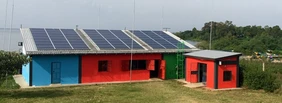Siemens Stiftung with its implementation partner WeTu Ltd aims to deliver sustainable and innovative solutions to improve lives in rural Kenya through three product lines: water services, solar lanterns, and e-mobility. So-called Water-Energy Hubs (WE Hubs) operated by WeTu Ltd enable the Kenyan population around Lake Victoria to access sustainably generated electricity and clean drinking water (see Figure 1). PV-generated electricity is used for water purification as well as for charging special floatable lanterns for night fishing.
In order to expand the service delivery of the WE Hubs, E-mobility solutions were intended to be integrated into the WE Hubs as additional electrical loads. This initiative was supported by GIZ and aimed at increasing economic capacity, tackling unemployment, and providing environmentally sustainable transport in the Lake Victoria region.
The following results have been achieved by the initiative with the support of the Institute of new Energy Systems (InES):
1. The InES together with the Siemens Stiftung developed a technical concept for implementing the E-mobility solutions into the existing WeTu Hub at Mbita. This concept serves as a blue-print for other WeTu Hubs.
2. Existing non-E-mobility load profiles were determined, as the energy demand depends on daily routines of the local community and is strongly linked with the fishing-season at Lake Victoria.
3. The potential for integrating further consumers within the context of E-mobility was determined.
4. A measurement investigation plan to assess the electricity consumption of the e-bikes was developed.
5. 450 fishing lanterns, auxiliary devices (i.e. water purification, computer, light bulbs, etc.), and 25 mobile batteries for electric bikes were assumed as the daily target to be charged at the Mbita WeTu Hub.
6. Daily and annual load profiles of the aforementioned loads were generated to simulate the annual electricity consumption and production of the Mbita WeTu Hub.
7. A simulation model utilised a 30 kWp PV array size and a 104 kWh central lead-acid battery size at Mbita WeTu Hub.
8. A best possible distribution of the different consumers throughout the day was of major importance for an economic feasible extension of the investigated WeTu Hub. Therefore, an appropriate control-strategy was developed.


![[Translate to English:] Logo Akkreditierungsrat: Systemakkreditiert](/fileadmin/_processed_/2/8/csm_AR-Siegel_Systemakkreditierung_bc4ea3377d.webp)








![[Translate to English:] Logo IHK Ausbildungsbetrieb 2023](/fileadmin/_processed_/6/0/csm_IHK_Ausbildungsbetrieb_digital_2023_6850f47537.webp)


